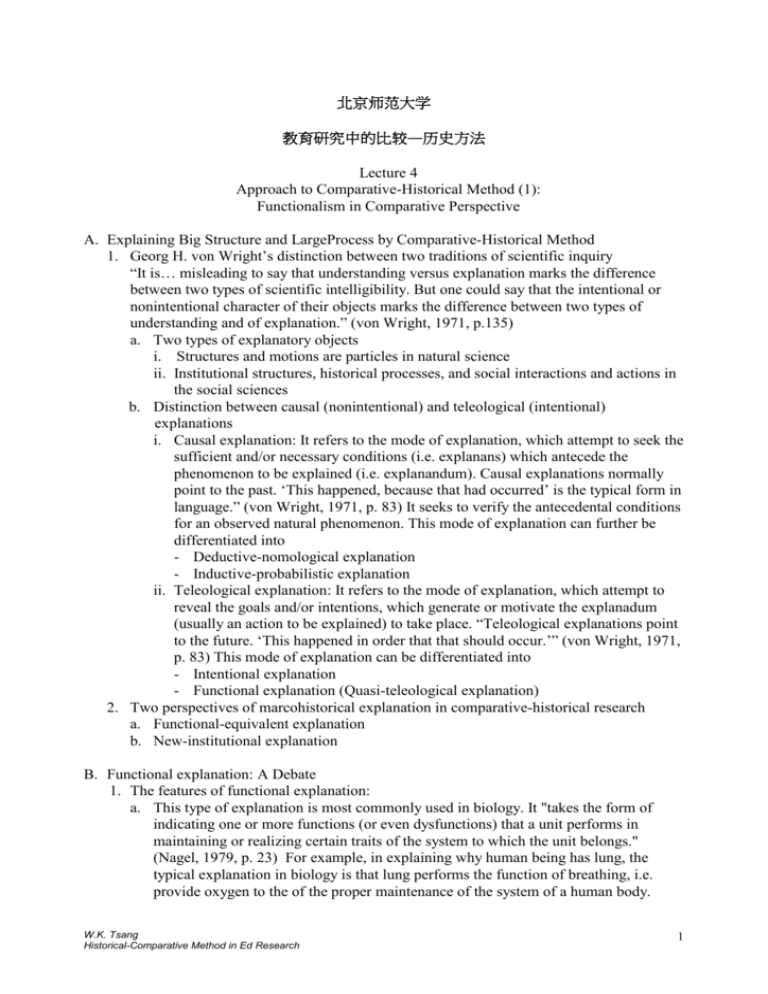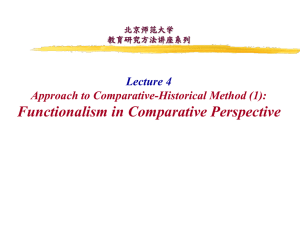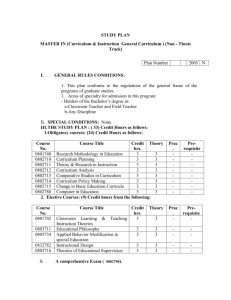Lecture 4: Functionalism
advertisement

北京师范大学 教育研究中的比较―历史方法 Lecture 4 Approach to Comparative-Historical Method (1): Functionalism in Comparative Perspective A. Explaining Big Structure and LargeProcess by Comparative-Historical Method 1. Georg H. von Wright’s distinction between two traditions of scientific inquiry “It is… misleading to say that understanding versus explanation marks the difference between two types of scientific intelligibility. But one could say that the intentional or nonintentional character of their objects marks the difference between two types of understanding and of explanation.” (von Wright, 1971, p.135) a. Two types of explanatory objects i. Structures and motions are particles in natural science ii. Institutional structures, historical processes, and social interactions and actions in the social sciences b. Distinction between causal (nonintentional) and teleological (intentional) explanations i. Causal explanation: It refers to the mode of explanation, which attempt to seek the sufficient and/or necessary conditions (i.e. explanans) which antecede the phenomenon to be explained (i.e. explanandum). Causal explanations normally point to the past. ‘This happened, because that had occurred’ is the typical form in language.” (von Wright, 1971, p. 83) It seeks to verify the antecedental conditions for an observed natural phenomenon. This mode of explanation can further be differentiated into - Deductive-nomological explanation - Inductive-probabilistic explanation ii. Teleological explanation: It refers to the mode of explanation, which attempt to reveal the goals and/or intentions, which generate or motivate the explanadum (usually an action to be explained) to take place. “Teleological explanations point to the future. ‘This happened in order that that should occur.’” (von Wright, 1971, p. 83) This mode of explanation can be differentiated into - Intentional explanation - Functional explanation (Quasi-teleological explanation) 2. Two perspectives of marcohistorical explanation in comparative-historical research a. Functional-equivalent explanation b. New-institutional explanation B. Functional explanation: A Debate 1. The features of functional explanation: a. This type of explanation is most commonly used in biology. It "takes the form of indicating one or more functions (or even dysfunctions) that a unit performs in maintaining or realizing certain traits of the system to which the unit belongs." (Nagel, 1979, p. 23) For example, in explaining why human being has lung, the typical explanation in biology is that lung performs the function of breathing, i.e. provide oxygen to the of the proper maintenance of the system of a human body. W.K. Tsang Historical-Comparative Method in Ed Research 1 b. The structure of functional explanation: Accordingly functional explanation consist of the followings i. X perform the function of Y to the system of Z ii. Y therefore explains the existence of X or Z's possession of Y. 2. A logical critique: There is a basic logical setback in this functional-explanatory structure. That is, since X performs Y, therefore X must be an antecedent of Y. However in the cause-effect explanatory structure, the existence of an effect (Y) could not have anteceded that of its cause (X). Therefore, Y could not have been the cause of X. 3. Darwinist functionalism in biology: In biology and with Darwin’s evolutionism the logical setback of functional explanation can be resolved with the mechanism of natural selection in the theory of evolution. That is, the seemingly temporal ordering mismatch between X and Y can be accounted for within the much longer timeline in the survivalof-the-fittest process of species within the ecological system of the planet earth. G.A. Cohen has called this requirement in functional explanation "consequence law" or “consequence generalization (Cohen, 1978, Pp.249-278; see also Elster, 1983, Pp.49-68) 4. Debate on functional explanation in the social sciences a. Jon Elster’s critique on functional explanation in social science: Jon Elster emphasizes that “there is no place for functional explanation in the social sciences.” (Elster, 1984, viii) The focal point of Elster’s criticism is that there is no commonly accepted "consequence generalization and law" available in social system, which can universally and exhaustively explain the existing status quo of a given social phenomenon. Unless we accept the thesis of social Darwinism that there is natural selection principle at work in social world, otherwise we may have to accept Jon Ester suggestion that functional explanation is not applicable in social science. b. Assumption of institutional resilience and persistence in social system: One resolution or qualification offered by Philip Pettit (2002) and Harold Kincaid (2007) is that instead of tracing all the way back to the origins of species and assuming that there is the evolutionism at work as biologists do, social scientists could restrain themselves relate functional explanation to the origins of social institutions and instead simply applying functional explanation to account for the resilient patterns or persistent regularities in social world. Such a qualification or reservation can release social scientists of the burden of proof of tracing the history of actual selection and evolution of the resilience of a social institution. Instead social scientists can simply base on a "virtual selection" assumption and focus on the accounting for the persistence of a given phenomenon. c. Another resolution to the debate is offered by G.SA. Cohen, an Analytical Marxist. In G.A. Cohen's two functional explanations in historical materialism, he offers more or less "a selection theory through class struggle" as the consequence law. i In the functional explanation of the relationship between force of production and relation of production (class relation) Cohen suggests "Classes are permanently poised against one another, and that class tends to prevail whose rule would best meet the demands of production. But how does the fact that production would prosper under a certain class ensure its dominance? Part of the answer is that there is a general stake in stable and striving production, so that the class best placed to deliver it attracts allies from other strata in society. Prospective ruling classes are often able to raise support among the classes subjected to the ruling class they would displace. Contrariwise, classes unsuited to the task of governing society tend to lack the confidence political hegemony W.K. Tsang Historical-Comparative Method in Ed Research 2 requires, and if they do seize power, they tend not to hold it for long." (Cohen, 1978, 292) ii. In the functional explanation of the relationship between infrastructure and superstructure, Cohen once again suggests "All classes are receptive to whatever ideas are likely to benefit them, and ruling classes are well placed to propagate ideologies particular congenial to themselves. But before an ideology is received or broadcast it has to be formed. And on that point there are traces in Marx of a Darwinian mechanism, a notion that thoughtsystems are produced in comparative independence from social constraint, but persist and gain social life for ideological service. …There is a kind of 'ideological pool' which yields elements in different configurations as social requirements change." (Cohen, 1978, p.291) B. From Functional Pre-requisite to Functional Equivalence: 1. The concept of functional prerequisite of social system: According to traditional functionalists, such as B. K. Malinowski, A,R. Radcliff-Brown and Talcott Parsons, function are conceived as "necessary conditions of the existence” of social systems (Kincaid, 2007, p.217). Parsons further specifies there are four basic functions that a social system has to perform in order to sustain in equilibrium state. (Kincaid, 2007, p.217) They are a. adaptation ― obtaining resource from the environment b. integration ― maintain coherent relationship among their component elements c. goal attainment ― setting goals and allocating resources to achieve them d. latency ― reproducing organizational structure and managing tension between units. Parsons has labeled them as four functional prerequisites, which imply and subsequently constitute a strong version of social functionalism in the social sciences. 2. The concept of functional equivalence: a. Critique on functional prerequisites: Parson’s strong version of prerequisite functional explanation has been criticized as structural-functionalism and structural determinism. b. To relax Parsonian structural-functionalism’s assumption on the functional prerequisite and totality of functional interconnection, we may simply redefine functions as contributions or benefits a given constituent offering to the maintaining of the essential core of the social system. Accordingly, the conception of functional prerequisite can be replaced by functional equivalence. As a result, what we are looking for are contributing and beneficial conditions instead of necessary conditions (or even sufficient condition) for the maintaining of the essential core of the social system. Furthermore, the strong version of specification of functional prerequisites into AGIL can also be relaxed. c. Dogan and Pelassy’s functional-equivalence comparison: i. Dogan and Pelassy underline first of all that “For comparativist, undoubtedly, functionalism is the most useful of all theoretical frameworks. By liberating analysis from its formal shackles, it permits progress that remains above criticism.” (1990, P. 35) ii. The notion of functional equivalence descends directly form the concept of ‘function’. …They have indeed emphasized with particular clarity, first, that the W.K. Tsang Historical-Comparative Method in Ed Research 3 same structure may perform the same function, and second, that the same structure may perform several function.” (P. 37) iii. In light of Dagan and Pelassy’s formulation, educational researchers using comparative-historical method could set of to account for big structures and large processes in education system by inquiring into what and how respective functional equivalences are served by these structures and processes serves; and how these big structures and large processes differ or match with each others. C. Jurgen Schriewer’s functional-cum-configurational model of comparative explanation. 1. Jürgen Schreiwer, one of the prominent researchers in the field of comparative education, applies the functional-equivalence perspective in comparative education studies by formulating a model, which he characterizes as “functional-cumconfigurational model” of comparative explanation. 2. The model may general be decomposed into two parts a. Functional-equivalence comparative studies: By locating the social institution under study, for example the institutionalization of universal schooling system, against different national contexts and/or various epoch contexts, researchers can set out to analyze how the functional-equivalent issues such as economic growth, state formation, or nation building are addressed by means of introduction of the universalized schooling system among comparable nation-states. b. Configurational-historical studies: Based on similarities and/or differences found from functional-equivalence comparison across nation-state, researchers can analyze how and why the institutional configurations of particular nation-states are structurated. Such process of structuration can further be put against the historical timeline of nation-states and analyze how the institutions under study evolve through time. c. These comparative-cum-historical studies as well as the functional-cumconfigurational studies can successively and complementarily be carried out so as to enrich and to thicken our understanding of big structures and large processes of our lifeworld. J. Perspectives of Functional Equivalence in Comparative Methods in Education Research 1. Functionalism: a. According to the Parsonsian functionalism, it assumes that societies are social systems, which are able to maintain most of the time in (A) states of adaptive to environments, (G) efficient in attaining societal goal in orderly and legitimate manner, (I) socially integrated, and (L) able to maintain its cultural and institutional patterns, in short in equilibrium state. b. As explicated in Lecture 2, functional explanations require generalized "consequence law" as basis to fulfill it temporal-order validity, such as the natural selection theory within evolutionism, which serves as the "consequence law" of functional explanation in biology. Accordingly, in Parsonsian functionalism, the "consequence law" underlying functional explanation is the equilibrium theory of social system. c. In Parsons' global concept of social system, (A) the function of economic institution is to fulfill the functional prerequisite of adaptation to environment, (G) the function of political institution is to attain the functional prerequisite of goal-attainment in orderly and legitimate ways, (I) social institutions is to perform the functional prerequisite of integration, and (L) cultural institutions is to contribute to the function prerequisite of W.K. Tsang Historical-Comparative Method in Ed Research 4 pattern maintenance. Taken together, they will achieve the overall equilibrium of the society. d. As for education institution, Parsons underlines that school class performs two essential functions to the equilibrium of the social system of modern society. i. Socialization function: "School class functions to internalize in its pupils both the commitments and capacities for successful performance of their future adult roles." (Parson, 2004, p. 32) ii. Selection function: School class on the other hand "functions to allocate these human resources within role-structure of the adult society." (p. 32) 2. Functional explanation in Marxian perspective: Marxian’s’ functional explanation of education institution in capitalist society can generally be summarized into two counts a. Reproduction function: As Louis Althusser indicates education is part of the ideological apparatus of the state, which performs the function of reproduction of the prevailing class relation of a given society. (Althusser, 1971; Carnoy, 1982; see also Bowles and Gintis, 1976; Bourdieu & Passeron, 1977; Apple, 1979) b. Legitimatizing function: Bowles and Gintis indicate that the highly selective and competitive structure of education does not only corresponds but in fact legitimatizing the inequality found in the class structure of capitalist society. )Bowles & Gintis, 1976) 3. Functional explanation of education in Weberian perspective a. Max Weber has rendered a function explanation of the relationship between education contents and forms of domination in societies. (Weber, 2004) b. Margret Archer has also expounded that domination and assertion among status groups as the primary factor contributing to education expansion in recent decades. 4. In light of these perspectives, the functional equivalence comparison framework can be elaborated as follow. Configuration Functional Equivalence Functionalism Socialization Function Similarity Difference Similarity Difference Selection Function Similarity Difference Marxism Reproduction Function Similarity Difference Legitimation Function Similarity Difference Weberian Perspective Domination Function Similarity Difference W.K. Tsang Historical-Comparative Method in Ed Research 5









